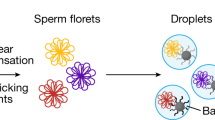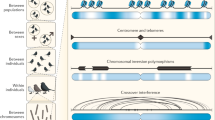Abstract
The fine-scale distribution of meiotic recombination events in the human genome can be inferred from patterns of haplotype diversity in human populations1,2,3,4,5 but directly studied only by high-resolution sperm typing6,7,8. Both approaches indicate that crossovers are heavily clustered into narrow recombination hot spots. But our direct understanding of hot-spot properties and distributions is largely limited to sperm typing in the major histocompatibility complex (MHC)7. We now describe the analysis of an unremarkable 206-kb region on human chromosome 1, which identified localized regions of linkage disequilibrium breakdown that mark the locations of sperm crossover hot spots. The distribution, intensity and morphology of these hot spots are markedly similar to those in the MHC. But we also accidentally detected additional hot spots in regions of strong association. Coalescent analysis of genotype data detected most of the hot spots but showed significant differences between sperm crossover frequencies and historical recombination rates. This raises the possibility that some hot spots, particularly those in regions of strong association, may have evolved very recently and not left their full imprint on haplotype diversity. These results suggest that hot spots could be very abundant and possibly fluid features of the human genome.
This is a preview of subscription content, access via your institution
Access options
Subscribe to this journal
Receive 12 print issues and online access
$209.00 per year
only $17.42 per issue
Buy this article
- Purchase on Springer Link
- Instant access to full article PDF
Prices may be subject to local taxes which are calculated during checkout





Similar content being viewed by others
References
Chakravarti, A. et al. Nonuniform recombination within the human beta-globin gene cluster. Am. J. Hum. Genet. 36, 1239–1258 (1984).
Gabriel, S.B. et al. The structure of haplotype blocks in the human genome. Science 296, 2225–2229 (2002).
Reich, D.E. et al. Human genome sequence variation and the influence of gene history, mutation and recombination. Nat. Genet. 32, 135–142 (2002).
Crawford, D.C. et al. Evidence for substantial fine-scale variation in recombination rates across the human genome. Nat. Genet. 36, 700–706 (2004).
McVean, G.A. et al. The fine-scale structure of recombination rate variation in the human genome. Science 304, 581–584 (2004).
Jeffreys, A.J., Ritchie, A. & Neumann, R. High-resolution analysis of haplotype diversity and meiotic crossover in the human TAP2 recombination hotspot. Hum. Mol. Genet. 9, 725–733 (2000).
Jeffreys, A.J., Kauppi, L. & Neumann, R. Intensely punctate meiotic recombination in the class II region of the major histocompatibility complex. Nat. Genet. 29, 217–222 (2001).
May, C.A., Shone, A.C., Kalaydjieva, L., Sajantila, A. & Jeffreys, A.J. Crossover clustering and rapid decay of linkage disequilibrium in the Xp/Yp pseudoautosomal gene SHOX. Nat. Genet. 31, 272–275 (2002).
Jeffreys, A.J. & May, C.A. Intense and highly localized gene conversion activity in human meiotic crossover hot spots. Nat. Genet. 36, 151–156 (2004).
Wang, N., Akey, J.M., Zhang, K., Chakraborty, R. & Jin, L. Distribution of recombination crossovers and the origin of haplotype blocks: the interplay of population history, recombination, and mutation. Am. J. Hum. Genet. 71, 1227–1234 (2002).
Phillips, M.S. et al. Chromosome-wide distribution of haplotype blocks and the role of recombination hot spots. Nat. Genet. 33, 382–387 (2003).
Stumpf, M.P. Haplotype diversity and SNP frequency dependence in the description of genetic variation. Eur. J. Hum. Genet. 12, 469–477 (2004).
Jeffreys, A.J., Murray, J. & Neumann, R. High-resolution mapping of crossovers in human sperm defines a minisatellite-associated recombination hotspot. Mol. Cell 2, 267–273 (1998).
Kong, A. et al. A high-resolution recombination map of the human genome. Nat. Genet. 31, 241–247 (2002).
Li, N. & Stephens, M. Modeling linkage disequilibrium and identifying recombination hotspots using single-nucleotide polymorphism data. Genetics 165, 2213–2233 (2003).
Fearnhead, P., Harding, R.M., Schneider, J.A., Myers, S. & Donnelly, P. Application of coalescent methods to reveal fine-scale rate variation and recombination hotspots. Genetics 167, 2067–2081 (2004).
Stephens, M. & Donnelly, P. A comparison of Bayesian methods for haplotype reconstruction from population genotype data. Am. J. Hum. Genet. 73, 1162–1169 (2003).
Gyapay, G. et al. The 1993-94 Généthon human genetic linkage map. Nat. Genet. 7, 246–339 (1994).
Morton, N.E. Outline of Genetic Epidemiology (Karger, Basel, 1982).
Reich, D.E. et al. Linkage disequilibrium in the human genome. Nature 411, 199–204 (2001).
Sabeti, P.C. et al. Detecting recent positive selection in the human genome from haplotype structure. Nature 419, 832–837 (2002).
Akey, J.M. et al. Population history and natural selection shape patterns of genetic variation in 132 genes. PLoS Biol. 2, e286 (2004).
Wall, J.D., Frisse, L.A., Hudson, R.R. & Di Rienzo, A. Comparative linkage-disequilibrium analysis of the beta-globin hotspot in primates. Am. J. Hum. Genet. 73, 1330–1340 (2003).
Ptak, S.E. et al. Absence of the TAP2 human recombination hotspot in chimpanzees. PLoS Biol. 2, 849–855 (2004).
Winckler, W. et al. Comparison of fine-scale recombination rates in humans and chimpanzees. Science 308, 107–111 (2005).
Ptak, S.E. et al. Fine-scale recombination patterns differ between chimpanzees and humans. Nat. Genet. 37, 429–434 (2005).
Stumpf, M.P. & McVean, G.A. Estimating recombination rates from population-genetic data. Nat. Rev. Genet. 4, 959–968 (2003).
Kauppi, L., Jeffreys, A.J. & Keeney, S. Where the crossovers are: recombination distributions in mammals. Nat. Rev. Genet. 5, 413–424 (2004).
Dean, F.B. et al. Comprehensive human genome amplification using multiple displacement amplification. Proc. Natl. Acad. Sci. USA 99, 5261–5266 (2002).
Griffiths, R.C. & Marjoram, P. An ancestral recombination graph. In IMA Volume on Mathematical Population Genetics (eds. Donnelly, P. & Tavaré, S.) 257–270 (Springer, Berlin/Heidelberg/New York, 1996).
Acknowledgements
We thank J. Blower and volunteers for providing semen and blood samples; S. Mistry for oligonucleotide synthesis; K. Holloway for DNA samples; C. May for website design; A. Webb for bioinformatics advice; P. Fearnhead, C. Freeman, J. Marchini and C. Spencer for coalescent analyses; and colleagues for discussions. This work was supported by grants to A.J.J. from the Medical Research Council, the Royal Society and the Louis-Jeantet Foundation and to P.D. from the US National Institutes of Health, the Nuffield Trust and the Wolfson Foundation.
Author information
Authors and Affiliations
Corresponding author
Ethics declarations
Competing interests
The authors declare no competing financial interests.
Rights and permissions
About this article
Cite this article
Jeffreys, A., Neumann, R., Panayi, M. et al. Human recombination hot spots hidden in regions of strong marker association. Nat Genet 37, 601–606 (2005). https://doi.org/10.1038/ng1565
Received:
Accepted:
Published:
Issue Date:
DOI: https://doi.org/10.1038/ng1565
This article is cited by
-
Loss of chromatin remodeler DDM1 causes segregation distortion in Arabidopsis thaliana
Planta (2021)
-
From molecules to populations: appreciating and estimating recombination rate variation
Nature Reviews Genetics (2020)
-
Identification of recombination hotspots and quantitative trait loci for recombination rate in layer chickens
Journal of Animal Science and Biotechnology (2019)
-
The potential of shifting recombination hotspots to increase genetic gain in livestock breeding
Genetics Selection Evolution (2017)
-
Recombination locations and rates in beef cattle assessed from parent-offspring pairs
Genetics Selection Evolution (2014)



